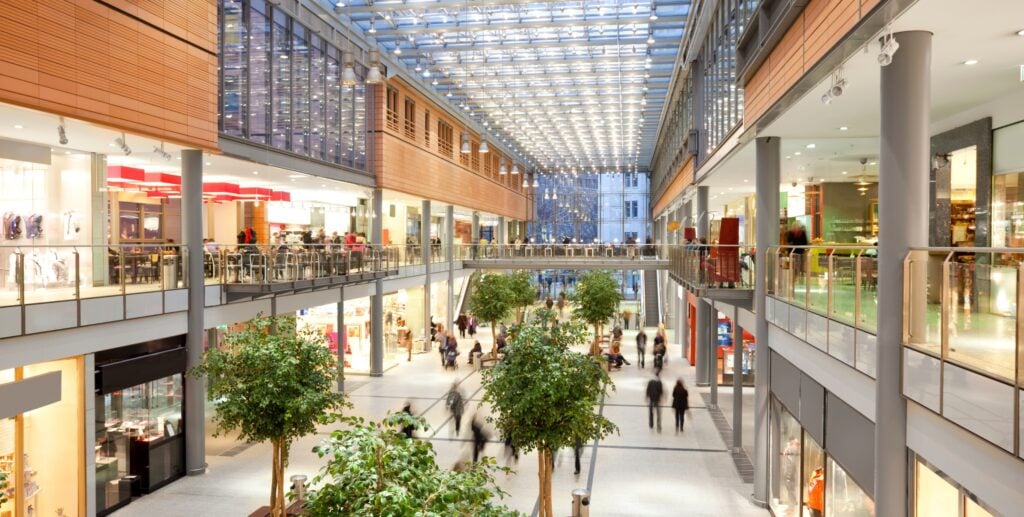At one point, the pandemic looked like it would be the final nail in the coffin for brick-and-mortar retail, speeding up the shift to e-commerce. But despite the benefits of online shopping, many people still enjoy going to a store to see and feel products up close.
Indeed, 67% of adults feel that way, and about 45% prefer visiting a store to shopping online, including 38% of Gen Zers, according to retail tracking data from Morning Consult.
Retail has remained surprisingly resilient, even though the share of online spending has not declined since the pandemic-era surge. In the second quarter, only 4.8% of retail space nationwide was available, according to CBRE, the lowest level in the 18 years the firm has tracked the rate. Meanwhile, the vacancy rate for office space hit 18.2%, a 30-year high.
But retail doesn’t automatically outperform. Major retailers, like Walmart and Foot Locker, are shutting down stores, and Bed Bath & Beyond closed 896 stores due to bankruptcy. Still, while retailers plan to close 3,500 stores, 4,500 new ones are expected to pop up in their place, according to Coresight Research.
Asking rents for retail space are also up 6.3% since the second quarter of 2020. Even so, investment in retail is declining from a 2022 boom, in part due to high interest rates. In the first half of 2023, the volume of total deals has fallen 48% when compared to the first half of 2022, according to MSCI data. The continued demand that landlords are seeing for retail space is likely due to low supply since retail construction dropped sharply after the 2008-2009 financial crisis.
Retail sales growth is expected to slow in 2023, according to Deloitte. And overall, employment in the retail sector is expected to decline by nearly 4% by 2030, according to the Bureau of Labor Statistics.
But with some firms warning of a commercial real estate crash, retail seems poised to survive, even if the sector may not be immune to pandemic-related changes in consumer behavior. This means there are opportunities for smart investors to take advantage of the major shifts happening in the retail sector.
Suburbanization is Changing Where People Shop
When the pandemic hit, busy urban areas began to appear less attractive as places to live. Remote work facilitated a mass exodus to the suburbs as people sought bigger backyards and more space to support more comfortable social distancing.
As a result, homebuyer demand in the suburbs increased dramatically, and about 2 million people left cities between 2020 and 2022. It was the first population loss metro areas experienced in decades. In the 10 biggest metros in the U.S., around half of the offices are currently vacant, according to data from Kastle Systems.
Though many workers have returned to the office in some capacity, 52% of remote-capable workers follow a hybrid work model, according to Gallup. What that means is that downtown areas aren’t getting the foot traffic they once were—more people are shopping where they live rather than where they work.
Indeed, foot traffic near city stores is still down 10% to 20% when compared to before the pandemic. As a result, McKinsey predicts that demand for retail space will drop 13% by 2030 in the median city; in San Francisco, demand could decline as much as 26%.
But for the first time since 2013, the vacancy rate for suburban retail was lower than the urban retail vacancy rate in 2022, according to CBRE data. Many chefs are choosing to locate their restaurants in the suburbs. For example, half of all Sweetgreen locations are now in the suburbs, compared to 35% in 2019. As retailers seek suburban space for their stores, many suburban landlords are reporting an increase in the share of leased properties since the start of 2023.
That creates an opportunity for investors to take advantage of demand in suburban areas. But precise location is still key, as suburbs located further away from metro areas are seeing waning demand, according to Lawrence Yun, chief economist at the National Association of Realtors.
Two Economies: High-End Malls and Dollar Stores
It’s been reported that high-income earners are fueling inflation with their spending while low-income earners struggle to make ends meet amid rising prices. This is largely due to the pandemic’s effects on wealth—white-collar workers were able to keep their jobs, and homeowners’ equity grew significantly during the homebuying boom, while low-income service workers were more likely to be adversely affected. Americans across income levels gained wealth, but those with fewer resources to begin with were more likely to have their budgets stretched thin by inflation.
That may be having an impact on which stores are most successful. Luxury retailers have plans to open stores in urban hubs that drew new residents during the pandemic, like Austin, Texas, and Nashville, Tennessee.
And while older, enclosed, low-end shopping malls accounted for two-thirds of distressed retail sales in 2023 thus far, some high-end malls are flourishing. Macerich, a real estate investment trust (REIT) that owns properties such as high-end malls in Arizona and Virginia, saw its highest leasing volume last year since the 2008-2009 financial crisis, and leasing this year is on track to exceed 2022’s numbers.
At the same time, dollar stores are leasing the most retail space this year, according to Coresight, with Dollar General aiming to open 1,000 stores. Discount chain Five Below also plans to open 200 stores. But middle-range retailers like Gap and Macy’s began hurting in 2022. Urban Outfitters, which reaches more affluent customers with brands Free People and Anthropologie, is seeing those stores succeed, while CEO Richard Hayne reported that the company’s “younger and less affluent” customers aren’t spending as much.
People are either looking for a bargain or hoping to buy luxury goods with their extra cash—but there’s not as much demand for middle-range stores, particularly in enclosed malls.
Innovative Retail Concepts Prevail
In an uncertain economy, many retailers may be facing the choice between innovation and death. Many of the technological innovations stores took up during the pandemic are here to stay, as consumers are expecting more self-service and in-store pickup options, McKinsey reports. For example, Target employees are cross-trained on how to quickly fulfill e-commerce orders.
Retailers are finding new ways to create positive experiences for in-store shoppers and meet shoppers where they’re at. For example, baby product retailer Lalo opened a New York brick-and-mortar store with free activities for babies so parents can enjoy distraction-free shopping. Claire’s has left low-rent mall locations behind in favor of partnerships with retailers like CVS to meet tween girls in places where their parents take them to shop.
Bank of America notes that the shift to customer engagement and e-commerce fulfillment may require fewer and smaller stores, which is something for retail real estate investors to consider when selecting properties.
Expert Tips for Investing in Retail
These shifts in the retail space and the sector’s resilience to the downturn in commercial real estate mean there are opportunities for investors who focus on the right properties in the right locations. We asked several real estate investment and financing advisors to weigh in on how real estate investors can get into the retail space. Here’s what they have to say.
Pay attention to consumer behavior
According to Noah Grayson, strategic financing advisor at PropertyCashin, “Consumers now spend more time at home, leading them to choose local shopping for convenience and to support nearby retailers.” And larger retailers are “embracing experiential and customer-engaging practices.”
Grayson says to stay up-to-date with what consumers want and where they shop to choose the best properties. He says retail investors should “stay knowledgeable about current market data to make informed decisions about the most promising retail investments.”
Engage in forward-thinking practices
In addition, Grayson says that “forward-thinking practices, such as investing in retail spaces that prioritize health and safety considerations amid concerns about future pandemics, as well as environmentally sustainable retail, have gained importance.”
This is especially true as more consumers are choosing places to shop that align with their values. For example, more than 40% of Gen Zers and millennials consider the sustainability of brands when making a purchase.
Make sure the numbers work
Jack Miller, strategic financing advisor at HouseCashin, says that no matter what’s happening in the retail sector, you have to make sure the numbers work. “We have been buying neighborhood strip centers for over 20 years,” he explains. “We have found that if you buy properties at a reasonable price, where you can lease them out at a reasonable rent, you will do fine.”
Armstead Jones, strategic real estate advisor at Real Estate Bees, adds that the high office vacancy rate also requires looking at indicators of demand for prospective locations, saying, “Investors should now look for retail opportunities that are focused on traffic counts and the number of people living by the assets.”
Consider upgrades, conversions, and mixed-use retail
Jones says that not-so-perfect properties present opportunities for investors. “These are the perfect times to find conversion opportunities that can have not only retail but housing options to provide customers to those retail tenants,” says Jones. “Properties that lack adequate upgrades and deferred maintenance present an opportunity for value add to help attract new/higher-paying tenants to drive cash flows.”
The Bottom Line
Nationwide, retail has been resilient thus far, but its success may be overstated due to a low supply of retail properties keeping rents high and occupancy rates low. And in metro areas like Chicago and New York, stores are sitting empty.
In many ways, retail is shifting rather than thriving across the board. Suburban restaurants, high-end shopping centers, and dollar stores are all performing well. Investors who pay attention to the trends stand to profit from the right opportunities.
Ready to succeed in real estate investing? Create a free BiggerPockets account to learn about investment strategies; ask questions and get answers from our community of +2 million members; connect with investor-friendly agents; and so much more.
Note By BiggerPockets: These are opinions written by the author and do not necessarily represent the opinions of BiggerPockets.





















Discussion about this post